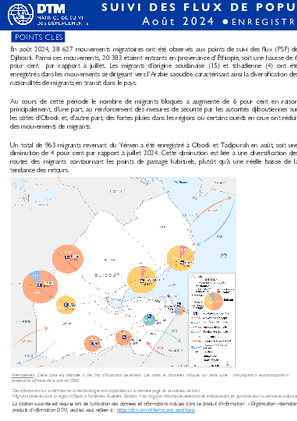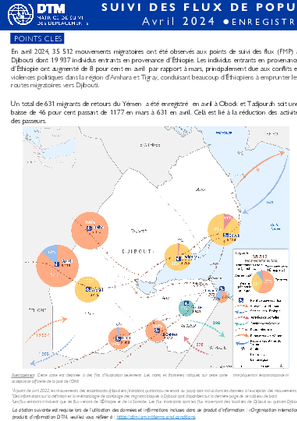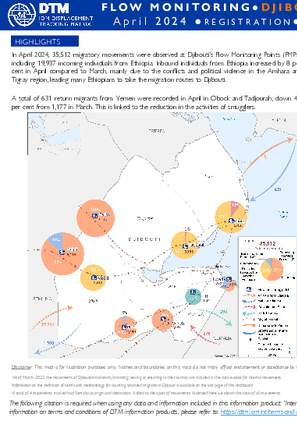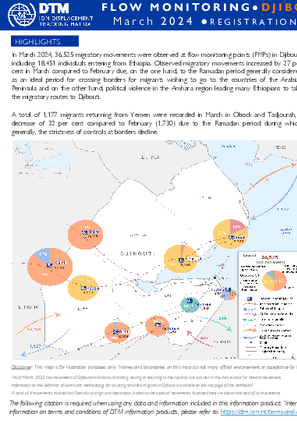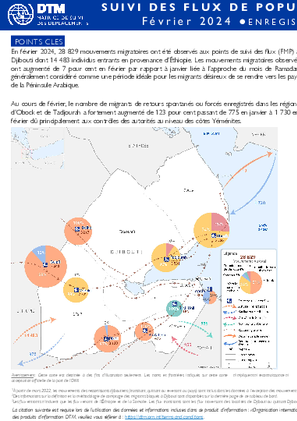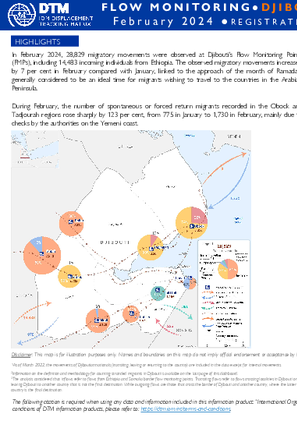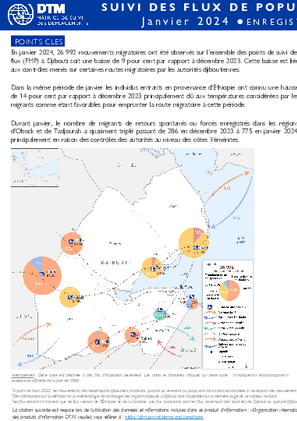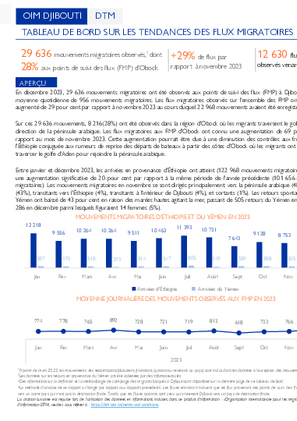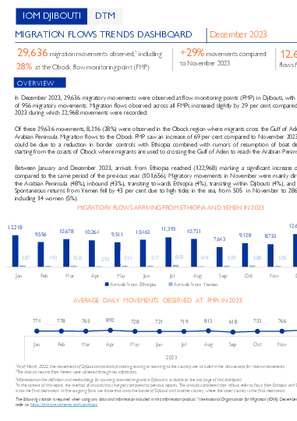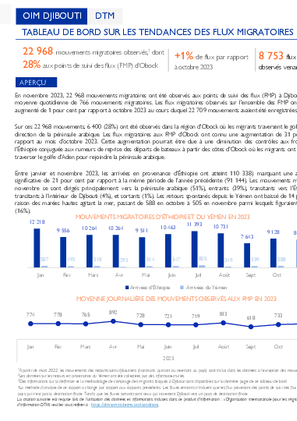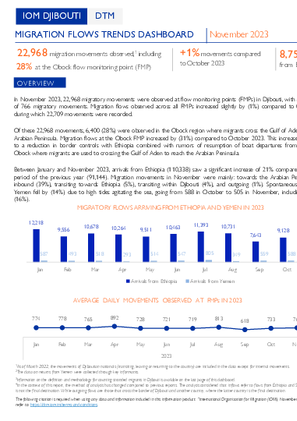-
Countries
-
Data and Analysis
-
Special Focus
-
Crisis Responses
Djibouti
Djibouti
Suivi des PDI
Mouvements de déplacement
Aucun chiffre n’est disponible
IDMC 2023
cycle de collecte de données
À propos Djibouti
À Djibouti, la DTM a été activée en Mai 2017, en réponse à d’importants mouvements migratoires principalement de l’Ethiopie vers le Yémen et l’Arabie saoudite à travers la Corne de l’Afrique. La DTM est opérationnelle à Djibouti pour recueillir, analyser et diffuser des informations critiques à plusieurs niveaux sur la mobilité, les vulnérabilités et les besoins des migrants en déplacement, ce qui permet aux décideurs et aux partenaires qui répondent de fournir une assistance ciblée et adaptée au contexte.
Afin de faciliter les interventions humanitaires, DTM travaille en étroite collaboration avec les autres programmes de l'OIM en orientant les populations ayant besoin d'assistance identifiées aux points de suivi des flux vers les programmes d'Assistance Directe, de Santé, de Retour Humanitaire Volontaire (VHR), de Protection et de Mécanismes de Ressources et de Réponse pour les Migrants (MRRM) de l'OIM. En outre, DTM Djibouti soutient des partenaires gouvernementaux tels que l’Office National d’Assistance aux Réfugiés et Sinistré (ONARS), l'Institut National de la Statistique de Djibouti (INSD) et d'autres partenaires, notamment l'UNICEF, le HCR, le PAM, l'UNOPS, le CICR et le DRC, afin de mieux comprendre les schémas de migration via Djibouti pour une meilleure planification des interventions.
Contacter
DTM Djibouti
dtmdjibouti@iom.int
Bailleurs de fonds
- EU
- DANIDA
- Japan
- Germany
- PRM
- SIDA
Djibouti — Tableau de Bord de Suivi des Flux (Octobre 2024)
En octobre 2024, 44 273 mouvements migratoires ont été observés aux points de suivi des flux (PSF) de Djibouti. Parmi ces mouvements, 22 617 étaient entrants en provenance d'Éthiopie soit une hausse de 14 pour cent par rapport à septembre.
Djibouti — Flow Monitoring Dashboard (October 2024)
In October 2024, 44,273 migratory movements were observed at flow monitoring points (FMPs) in Djibouti. Of these movements, 22,617 were inbound from Ethiopia, an increase of 14 per cent compared to September.
Djibouti — Tableau de Bord de Suivi des Flux (Septembre 2024)
En septembre 2024, 43 330 mouvements migratoires ont été observés aux points de suivi des flux (PSF) de Djibouti. Parmi ces mouvements, 19 838 étaient entrants en provenance d'Éthiopie.
Djibouti — Flow Monitoring Dashboard (September 2024)
In September 2024, 43,330 migratory movements were observed at Djibouti's flow monitoring points(FMPs). Of these movements, 19,838 were inbound from Ethiopia.
Djibouti — Tableau de Bord de Suivi des Flux (Août 2024)
En août 2024, 38 627 mouvements migratoires ont été observés aux points de suivi des flux (PSF) de Djibouti. Parmi ces mouvements, 20 383 étaient entrants en provenance d'Éthiopie, soit une hausse de 6 % par rapport à juillet.
Djibouti — Flow Monitoring Dashboard (August 2024)
In August 2024, 38,627 migratory movements were observed at Djibouti's flow monitoring points (FMPs). Of these movements, 20,383 were inbound from Ethiopia, an increase of 6 per cent from July.
Djibouti — Tableau de Bord de Suivi des Flux (Juillet 2024)
En juillet 2024, 40 118 mouvements migratoires ont été observés aux points de suivi des flux (PSF) à Djibouti, dont 19 310 entrants en provenance d'Éthiopie.
Djibouti — Flow Monitoring Dashboard (July 2024)
In July 2024, 40,118 migratory movements were observed at flow monitoring points (PSF) in Djibouti, including 19,310 incoming from Ethiopia.
Sep 09 2024
Djibouti — Flow Monitoring Dashboard (July 2024)
Djibouti — Flow Monitoring Dashboard (June 2024)
In June 2024, 39,336 migratory movements were observed at Djibouti's flow monitoring points (FMPs), including 17,938 arrivals from Ethiopia, representing a 17 per cent increase in migratory movements compared with May, mainly due to the conflicts in the Amhara and Tigray regions, which prompted m
Jul 29 2024
Djibouti — Flow Monitoring Dashboard (June 2024)
Djibouti — Tableau de Bord de Suivi des Flux (Juin 2024)
En juin 2024, 39 336 mouvements migratoires ont été observés aux points de suivi des flux (FMP) de Djibouti, dont 17 938 arrivées en provenance d'Éthiopie, soit une augmentation de 17 pour cent des mouvements migratoires par rapport au mois de mai, principalement en raison des conflits dans les r
Djibouti — Flow Monitoring Dashboard (May 2024)
In May 2024, 33,685 migratory movements were observed at Djibouti's Flow Monitoring Points (FMPs), including 17,319 inbound individuals from Ethiopia.
Jun 27 2024
Djibouti — Flow Monitoring Dashboard (May 2024)
Djibouti — Tableau de bord de suivi des flux (Mai 2024)
En mai 2024, 33 685 mouvements migratoires ont été observés aux points de suivi des flux (PSF) à Djibouti dont 17 319 individus entrants en provenance d’Éthiopie.
Djibouti — Tableau de bord de suivi des flux (Avril 2024)
En avril 2024, 35 512 mouvements migratoires ont été observés aux points de suivi des flux (FMP) à Djibouti dont 19 937 individus entrants en provenance d’Éthiopie.
Djibouti — Flow Monitoring Dashboard (April 2024)
In April 2024, 35,512 migratory movements were observed at Djibouti's Flow Monitoring Points (FMPs), including 19,937 incoming individuals from Ethiopia.
Djibouti — Flow Monitoring Dashboard (March 2024)
In March 2024, 36,525 migratory movements were observed at flow monitoring points (FMPs) in Djibouti, including 18,451 individuals entering from Ethiopia.
Djibouti — Tableau de bord de suivi des flux (Mars 2024)
En mars 2024, 36 525 mouvements migratoires ont été observés aux points de suivi des flux (FMP) à Djibouti dont 18 451 individus entrants en provenance d’Éthiopie.
Djibouti — Tableau de bord de suivi des flux (Février 2024)
En février 2024, 28 829 mouvements migratoires ont été observés aux points de suivi des flux (FMP) à Djibouti dont 14 483 individus entrants en provenance d’Éthiopie.
Djibouti — Flow Monitoring Dashboard (February 2024)
In February 2024, 28,829 migratory movements were observed at Djibouti's Flow Monitoring Points (FMPs), including 14,483 incoming individuals from Ethiopia.
Djibouti — Tableau de bord de suivi des flux (Janvier 2024)
En janvier 2024, 26 992 mouvements migratoires ont été observés sur l’ensemble des points de suivi des flux (FMP) à Djibouti soit une baisse de 9 pour cent par rapport à décembre 2023.
Djibouti — Flow Monitoring Dashboard (January 2024)
In January 2024, 26,992 migratory movements were observed at all Djibouti's Flow Monitoring Points (FMPs) with a decrease of 9 per cent compared with December 2023. This drop is linked to the controls carried out on certain migration routes by the Djibouti authorities.
Djibouti - Rapport sur les points de suivi des flux (décembre 2023)
En décembre 2023, 29 636 mouvements migratoires ont été observés aux points de suivi des flux (FMP) à Djibouti, avec une moyenne quotidienne de 956 mouvements migratoires.
Djibouti - Migration Trends Dashboard (December 2023)
In December 2023, 29,636 migratory movements were observed at flow monitoring points (FMP) in Djibouti, with a daily average of 956 migratory movements.
Djibouti — Rapport sur les Points de suivi des flux (Novembre 2023)
En novembre 2023, 22 968 mouvements migratoires ont été observés aux points de suivi des flux (FMP) à Djibouti, avec une moyenne quotidienne de 766 mouvements migratoires.
Djibouti — Migration Trends Dashboard (November 2023)
In November 2023, 22,968 migratory movements were observed at flow monitoring points (FMPs) in Djibouti, with a daily average of 766 migratory movements. Migration flows observed across all FMPs increased slightly by (1%) compared to October 2023 during which 22,709 movements were recorded.
Pagination
Djibouti – Mobility Tracking assessment – ROUND 1 – September 2022
2022-09-10
In order to inform the humanitarian response, IOM, in collaboration with the National Statistics Institute (INSTAD) and local authorities, conducted rapid assessments in the regions of Ali-Sabieh, Tadjourah, Dikhil, Arta and Obock. The first rapid assessment was conducted between the 27th of July…
Djibouti — Flow monitoring — May 2019
2019-05-31
Flow monitoring aims to derive quantitative estimates of the flow of individuals through specific locations and to collect information about the profile, intentions and needs of the people moving and to quantify highly mobile populations by providing a picture of complex mobility dynamics.
Djibouti - Flow monitoring - April 2019
2019-04-30
Flow monitoring aims to derive quantitative estimates of the flow of individuals through specific locations and to collect information about the profile, intentions and needs of the people moving and to quantify highly mobile populations by providing a picture of complex mobility dynamics.
Djibouti - Flow monitoring - March 2019
2019-03-30
Flow monitoring aims to derive quantitative estimates of the flow of individuals through specific locations and to collect information about the profile, intentions and needs of the people moving and to quantify highly mobile populations by providing a picture of complex mobility dynamics.
Djibouti - Flow monitoring - Février 2019
2019-02-28
Flow monitoring aims to derive quantitative estimates of the flow of individuals through specific locations and to collect information about the profile, intentions and needs of the people moving and to quantify highly mobile populations by providing a picture of complex mobility dynamics.
Djibouti - Flow monitoring - January 2019
2019-01-31
Flow monitoring aims to derive quantitative estimates of the flow of individuals through specific locations and to collect information about the profile, intentions and needs of the people moving and to quantify highly mobile populations by providing a picture of complex mobility dynamics.
Djibouti - Flow monitoring December 2018
2018-12-31
Flow monitoring aims to derive quantitative estimates of the flow of individuals through specific locations and to collect information about the profile, intentions and needs of the people moving and to quantify highly mobile populations by providing a picture of complex mobility dynamics.
Djibouti - Flow monitoring November 2018
2018-11-30
Flow monitoring aims to derive quantitative estimates of the flow of individuals through specific locations and to collect information about the profile, intentions and needs of the people moving and to quantify highly mobile populations by providing a picture of complex mobility dynamics.
Djibouti - Flow monitoring October 2018
2018-10-31
Flow monitoring aims to derive quantitative estimates of the flow of individuals through specific locations and to collect information about the profile, intentions and needs of the people moving and to quantify highly mobile populations by providing a picture of complex mobility dynamics.
Djibouti - Flow monitoring September 2018
2018-09-30
Flow monitoring aims to derive quantitative estimates of the flow of individuals through specific locations and to collect information about the profile, intentions and needs of the people moving and to quantify highly mobile populations by providing a picture of complex mobility dynamics.
Djibouti - Flow monitoring August 2018
2018-08-31
Flow monitoring aims to derive quantitative estimates of the flow of individuals through specific locations and to collect information about the profile, intentions and needs of the people moving and to quantify highly mobile populations by providing a picture of complex mobility dynamics.
Djibouti - Flow monitoring July 2018
2018-07-31
Flow monitoring aims to derive quantitative estimates of the flow of individuals through specific locations and to collect information about the profile, intentions and needs of the people moving and to quantify highly mobile populations by providing a picture of complex mobility dynamics.
Djibouti - Flow monitoring February 2018
2018-02-28
Flow monitoring aims to derive quantitative estimates of the flow of individuals through specific locations and to collect information about the profile, intentions and needs of the people moving and to quantify highly mobile populations by providing a picture of complex mobility dynamics.
Djibouti - Flow monitoring January 2018
2018-01-30
Flow monitoring aims to derive quantitative estimates of the flow of individuals through specific locations and to collect information about the profile, intentions and needs of the people moving and to quantify highly mobile populations by providing a picture of complex mobility dynamics.
Djibouti South - Flow monitoring December 2017
2017-12-31
Flow monitoring aims to derive quantitative estimates of the flow of individuals through specific locations and to collect information about the profile, intentions and needs of the people moving and to quantify highly mobile populations by providing a picture of complex mobility dynamics.






